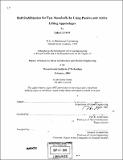Roll stabilization for fast monohulls by using passive and active lifting appendages
Author(s)
Ulusoy, Talha
DownloadFull printable version (14.95Mb)
Other Contributors
Massachusetts Institute of Technology. Dept. of Ocean Engineering.
Advisor
Paul D. Sclavounos.
Terms of use
Metadata
Show full item recordAbstract
Roll stabilization for monohulls is an important issue in naval architecture. Several methods including roll stabilization tanks, active control fins, rudder roll stabilization systems, and bilge keels are commonly used for roll stabilization purposes and each one of them has its own advantages and disadvantages. In this thesis roll stabilization is studied by using passive and active roll stabilization configurations with hydrofoils. The main objective of this research is to identify an effective roll stabilization system for use on high- speed monohull vessels. The analysis of the performance of a passive hydrofoil configuration is used as a starting point for the development of active control mechanisms. A generic fast monohull was created for study purposes and the SWAN-2 code (ShipWaveANalysis), a state-of-the-art time domain simulation program, was used for the analysis of the linear free-surface flow around the vessel. Simulations were carried out in regular waves incident at angles ranging from 90⁰, 105⁰,120⁰,135⁰ and 150⁰ degrees relative to the ship axis, 900 being beam waves and 180⁰ degree being head waves. The ship was equipped with a hydrofoil fixed amidships, quarter to aft and aft to determine the sensitivity of roll motion on the longitudinal position of the lifting appendage. (cont.) It was found that the most efficient location for the hydrofoil is amidships leading to a 20% to 60% roll motion reduction (depending on the wave angle and ship speed) of the RMS value of roll motion in an ISSC spectrum. Also studies were performed to determine the planform area of the hydrofoil for optimal roll motion reduction. In addition, four different Froude numbers are used, ranging from 0.3 to 0.9, to evaluate the effect of the speed on the effectiveness of the lifting appendage. As expected, higher speeds lead to better seakeeping performance, namely better roll reduction compared to lower speeds. Passive hydrofoils were found to be very effective in reducing the rolling motion. Active roll control mechanisms were also investigated by seeking the optimal time-dependent variation of the modulus and phase of the hydrofoil angle of attack and found to be very effective leading to increased roll reduction. The development of such optimal control algorithms is expected to lead to an enhanced roll seakeeping performance over a broader range of sea state conditions and ship speeds.
Description
Thesis (S.M.)--Massachusetts Institute of Technology, Dept. of Ocean Engineering, 2004. Includes bibliographical references (p. 91-92).
Date issued
2004Department
Massachusetts Institute of Technology. Department of Ocean EngineeringPublisher
Massachusetts Institute of Technology
Keywords
Ocean Engineering.